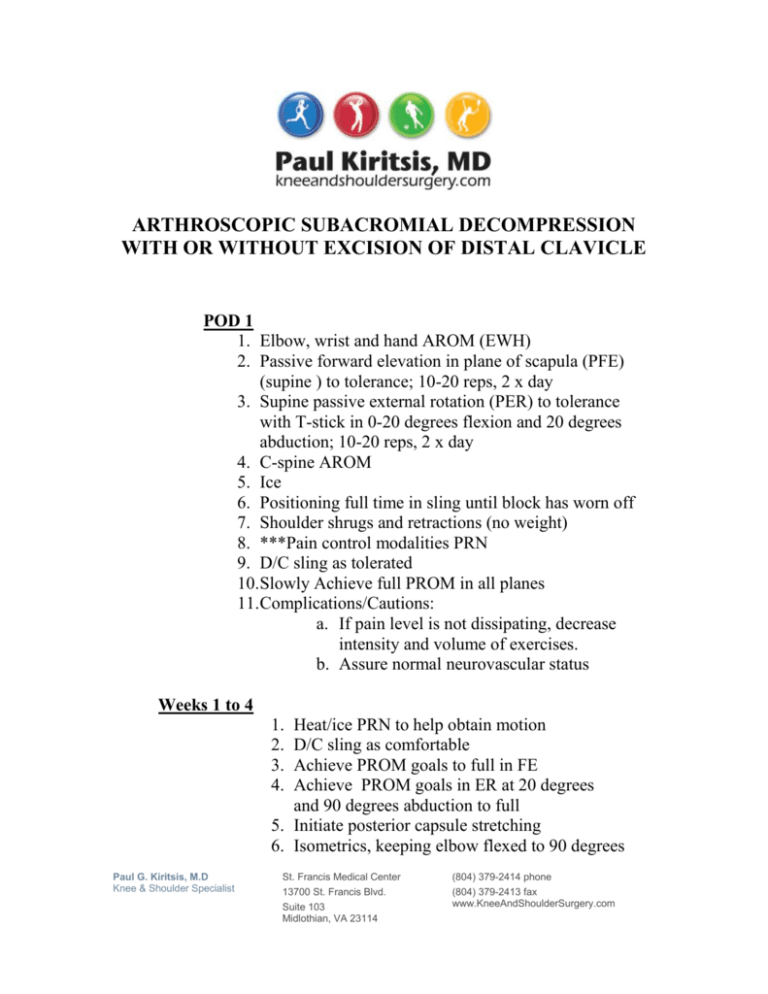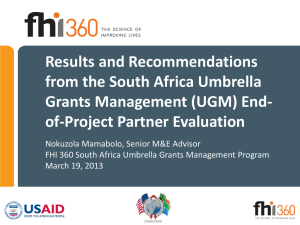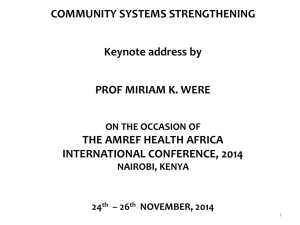arthroscopic subacromial decompression with or without excision of
advertisement

ARTHROSCOPIC SUBACROMIAL DECOMPRESSION WITH OR WITHOUT EXCISION OF DISTAL CLAVICLE POD 1 1. Elbow, wrist and hand AROM (EWH) 2. Passive forward elevation in plane of scapula (PFE) (supine ) to tolerance; 10-20 reps, 2 x day 3. Supine passive external rotation (PER) to tolerance with T-stick in 0-20 degrees flexion and 20 degrees abduction; 10-20 reps, 2 x day 4. C-spine AROM 5. Ice 6. Positioning full time in sling until block has worn off 7. Shoulder shrugs and retractions (no weight) 8. ***Pain control modalities PRN 9. D/C sling as tolerated 10.Slowly Achieve full PROM in all planes 11.Complications/Cautions: a. If pain level is not dissipating, decrease intensity and volume of exercises. b. Assure normal neurovascular status Weeks 1 to 4 1. 2. 3. 4. Heat/ice PRN to help obtain motion D/C sling as comfortable Achieve PROM goals to full in FE Achieve PROM goals in ER at 20 degrees and 90 degrees abduction to full 5. Initiate posterior capsule stretching 6. Isometrics, keeping elbow flexed to 90 degrees Paul G. Kiritsis, M.D Knee & Shoulder Specialist St. Francis Medical Center 13700 St. Francis Blvd. Suite 103 Midlothian, VA 23114 (804) 379-2414 phone (804) 379-2413 fax www.KneeAndShoulderSurgery.com (Sub maximal, pain free) 7. Theraband scapula retractions 8. ***Aquatics 9. ***Mobilizations PRN 10.***Trunk stabilization/strengthening 11.Start AAFE and progress to AFE 12.Start periscapular strengthening with very low weight and high repetitions 13.Cautions: a. Do not initiate rotator cuff strengthening until 3-4 weeks and until night pain has subsided and overall pain level is low Weeks 4 to 12 1. 2. 3. 4. 5. 6. 7. Continue as above ROM should be full in all planes Progress isometrics Advance scapula strengthening ***Mobilizations PRN ***Aquatics for strengthening ***CKC activities for dynamic stability of scapula deltoid and cuff 8. ***Trunk stabilization/strengthening 9. ***Light PNF D1, D2 and manual resistance for cuff/deltoid/scapula (rhythmic stabilization or slow reversal hold) 10.Initiate theraband ER and IR strengthening 11.Progressive serratus anterior strengthening (isolated pain free, elbow by side) 12.Progress to isotonic dumbbell exercises for deltoid and supraspinatus 13.Cautions: a. Assure normal scapulohumeral rhythm with AAFE and AFE b. Strengthening program should progress only without signs of increasing inflammation Paul G. Kiritsis, M.D Knee & Shoulder Specialist St. Francis Medical Center 13700 St. Francis Blvd. Suite 103 Midlothian, VA 23114 (804) 379-2414 phone (804) 379-2413 fax www.KneeAndShoulderSurgery.com c. Strengthening program should emphasize high repetitions, low weight and should be performed a maximum of 2 x day Phase III: (Return to activity/advanced conditioning) Goals: Normalize strength, endurance and power Return to full ADL’s and recreational activities Month 3 to 6 1. Stretching PRN 2. Continue deltoid/cuff/and scapula strengthening as above with the following progressions: a. Prone isotonic strengthening PRN b. Decreasing amounts of external stabilization provided to shoulder girdle c. Integrate functional patterns d. Increase speed of movements e. Integrate kinesthetic awareness drills into strengthening activities f. Decrease in rest time to improve endurance 3. May begin tennis ground stroke/batting/return to golf after completing strengthening progression 4. ***Progressive CKC dynamic stability activities 5. ***Impulse 6. ***Initiate isokinetic strengthening 7. ***Mobilizations PRN 8. ***Trunk stabilization/strengthening Month 6 to 8 1. Stretching PRN 2. Continue deltoid/cuff/scapula strengthening program 3. Initiate plyometric program (if needed) a. Do not begin until 5/5 MMT for rotator cuff and scapula b. QD at most Paul G. Kiritsis, M.D Knee & Shoulder Specialist St. Francis Medical Center 13700 St. Francis Blvd. Suite 103 Midlothian, VA 23114 (804) 379-2414 phone (804) 379-2413 fax www.KneeAndShoulderSurgery.com








